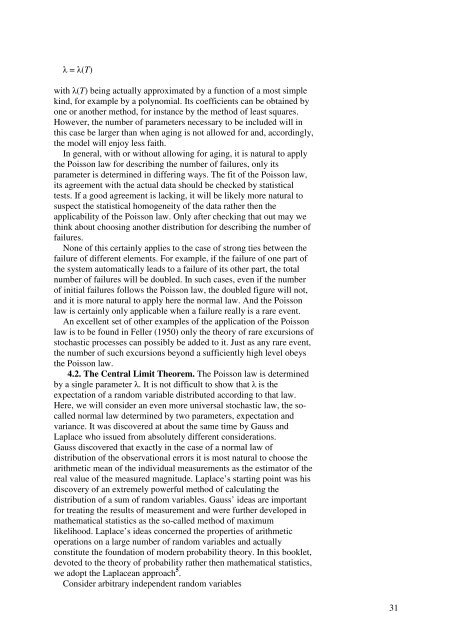1 Studies in the History of Statistics and Probability ... - Sheynin, Oscar
1 Studies in the History of Statistics and Probability ... - Sheynin, Oscar
1 Studies in the History of Statistics and Probability ... - Sheynin, Oscar
Create successful ePaper yourself
Turn your PDF publications into a flip-book with our unique Google optimized e-Paper software.
λ = λ(T)with λ(T) be<strong>in</strong>g actually approximated by a function <strong>of</strong> a most simplek<strong>in</strong>d, for example by a polynomial. Its coefficients can be obta<strong>in</strong>ed byone or ano<strong>the</strong>r method, for <strong>in</strong>stance by <strong>the</strong> method <strong>of</strong> least squares.However, <strong>the</strong> number <strong>of</strong> parameters necessary to be <strong>in</strong>cluded will <strong>in</strong>this case be larger than when ag<strong>in</strong>g is not allowed for <strong>and</strong>, accord<strong>in</strong>gly,<strong>the</strong> model will enjoy less faith.In general, with or without allow<strong>in</strong>g for ag<strong>in</strong>g, it is natural to apply<strong>the</strong> Poisson law for describ<strong>in</strong>g <strong>the</strong> number <strong>of</strong> failures, only itsparameter is determ<strong>in</strong>ed <strong>in</strong> differ<strong>in</strong>g ways. The fit <strong>of</strong> <strong>the</strong> Poisson law,its agreement with <strong>the</strong> actual data should be checked by statisticaltests. If a good agreement is lack<strong>in</strong>g, it will be likely more natural tosuspect <strong>the</strong> statistical homogeneity <strong>of</strong> <strong>the</strong> data ra<strong>the</strong>r <strong>the</strong>n <strong>the</strong>applicability <strong>of</strong> <strong>the</strong> Poisson law. Only after check<strong>in</strong>g that out may weth<strong>in</strong>k about choos<strong>in</strong>g ano<strong>the</strong>r distribution for describ<strong>in</strong>g <strong>the</strong> number <strong>of</strong>failures.None <strong>of</strong> this certa<strong>in</strong>ly applies to <strong>the</strong> case <strong>of</strong> strong ties between <strong>the</strong>failure <strong>of</strong> different elements. For example, if <strong>the</strong> failure <strong>of</strong> one part <strong>of</strong><strong>the</strong> system automatically leads to a failure <strong>of</strong> its o<strong>the</strong>r part, <strong>the</strong> totalnumber <strong>of</strong> failures will be doubled. In such cases, even if <strong>the</strong> number<strong>of</strong> <strong>in</strong>itial failures follows <strong>the</strong> Poisson law, <strong>the</strong> doubled figure will not,<strong>and</strong> it is more natural to apply here <strong>the</strong> normal law. And <strong>the</strong> Poissonlaw is certa<strong>in</strong>ly only applicable when a failure really is a rare event.An excellent set <strong>of</strong> o<strong>the</strong>r examples <strong>of</strong> <strong>the</strong> application <strong>of</strong> <strong>the</strong> Poissonlaw is to be found <strong>in</strong> Feller (1950) only <strong>the</strong> <strong>the</strong>ory <strong>of</strong> rare excursions <strong>of</strong>stochastic processes can possibly be added to it. Just as any rare event,<strong>the</strong> number <strong>of</strong> such excursions beyond a sufficiently high level obeys<strong>the</strong> Poisson law.4.2. The Central Limit Theorem. The Poisson law is determ<strong>in</strong>edby a s<strong>in</strong>gle parameter λ. It is not difficult to show that λ is <strong>the</strong>expectation <strong>of</strong> a r<strong>and</strong>om variable distributed accord<strong>in</strong>g to that law.Here, we will consider an even more universal stochastic law, <strong>the</strong> socallednormal law determ<strong>in</strong>ed by two parameters, expectation <strong>and</strong>variance. It was discovered at about <strong>the</strong> same time by Gauss <strong>and</strong>Laplace who issued from absolutely different considerations.Gauss discovered that exactly <strong>in</strong> <strong>the</strong> case <strong>of</strong> a normal law <strong>of</strong>distribution <strong>of</strong> <strong>the</strong> observational errors it is most natural to choose <strong>the</strong>arithmetic mean <strong>of</strong> <strong>the</strong> <strong>in</strong>dividual measurements as <strong>the</strong> estimator <strong>of</strong> <strong>the</strong>real value <strong>of</strong> <strong>the</strong> measured magnitude. Laplace’s start<strong>in</strong>g po<strong>in</strong>t was hisdiscovery <strong>of</strong> an extremely powerful method <strong>of</strong> calculat<strong>in</strong>g <strong>the</strong>distribution <strong>of</strong> a sum <strong>of</strong> r<strong>and</strong>om variables. Gauss’ ideas are importantfor treat<strong>in</strong>g <strong>the</strong> results <strong>of</strong> measurement <strong>and</strong> were fur<strong>the</strong>r developed <strong>in</strong>ma<strong>the</strong>matical statistics as <strong>the</strong> so-called method <strong>of</strong> maximumlikelihood. Laplace’s ideas concerned <strong>the</strong> properties <strong>of</strong> arithmeticoperations on a large number <strong>of</strong> r<strong>and</strong>om variables <strong>and</strong> actuallyconstitute <strong>the</strong> foundation <strong>of</strong> modern probability <strong>the</strong>ory. In this booklet,devoted to <strong>the</strong> <strong>the</strong>ory <strong>of</strong> probability ra<strong>the</strong>r <strong>the</strong>n ma<strong>the</strong>matical statistics,we adopt <strong>the</strong> Laplacean approach 5 .Consider arbitrary <strong>in</strong>dependent r<strong>and</strong>om variables31









